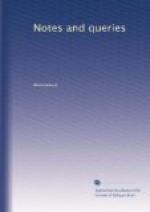Jacobus Praefectus Siculus.—I have a beautiful copy of a poem by this person, entitled De Verbo DEI Cantica. The binding expresses its date: “Neapoli, 1537.” It is not, I believe, the work which suggested to Milton his greater songs, though it is a pretty complete outline of the Paradise Lost and Regained/ What is known about the author, or any other works of his?
J.W.H.
The Word “after” in the Rubric—Canons of 1604.—
1. Can any of your correspondents who may have in their possession any old Greek, or Latin, or other versions, of the Book of Common Prayer, kindly inform me how the word after is rendered in the rubrics of the General Confession, the Lord’s Prayer in the Post Communion, and the last prayer of the Commination Service? Is it in the sense of post or secundum?
2. Where can any account of the translation of the Canons of 1604 into English be found? It is apprehended the question is one more difficult to answer than might be supposed.
T.Y.
Hard by.—Is not hard by a corruption of the German hierbei? I know no other similar instance of the word hard, that is to say, as signifying proximity, without the conjoint idea of pressure or pursuit.
K.
Thomas Rogers of Horninger.—Can any of the readers of your valuable publication give me, or put me in the way of obtaining, any information about one Thomas Rogers, who was in some way connected with the village of Horninger or Horringer, near Bury St. Edmunds, was author of a work on the Thirty-nine Articles, and died in the year 1616?
S.G.
Corpus Christi Col., Cambridge.
Armorial Bearings.—Three barrulets charged with six church bells, three, two, and one, is a shield occurring in the Speke Chauntry, in Exeter Cathedral. Can this coat be assigned?
J.W.H.
Lady Compton’s Letter to her Husband.—In Bishop Goodman’s Court of King James I., edited by John S. Brewer, M.A. (vol. ii. p. 127..), is a letter from Lady Compton to her husband, William Lord Compton, afterwards Earl of Northampton, written upon occasion of his coming into possession of a large fortune. This letter, with some important variations, is also given in Knight’s London (vol. i. p. 324.), and, if my memory does not deceive me, in Hewitt’s Visits to Remarkable Places. This letter is very curious, but I can hardly think it genuine. Can any of your correspondents throw any light on the matter? Was it printed before 1839, when Mr. Brewer’s work appeared? Where is the original, or supposed original, to be seen? Above all, is it authentic? If not, is it known when, and by {425} whom, and under what circumstances it was written?
C.H. COOPER.
Cambridge, November 15. 1850.
Romagnasi’s Works.—In a “Life of G.D. Romagnasi,” in vol. xviii. Law Mag., p. 340., after enumerating several of his works, it is added, “All these are comprised in a single volume, Florentine edit. of 1835.” I have in vain endeavoured to procure the work, and have recently received an answer from the first book establishment in Florence, to the effect that no such edition ever appeared either at Florence or elsewhere.




